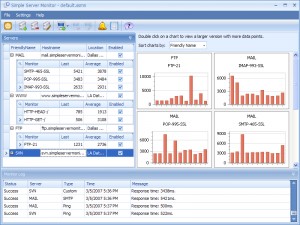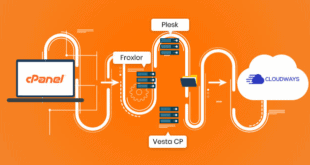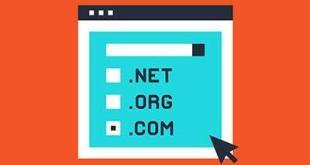 There are obvious benefits to having access to a dedicated server that is solely devoted to the performance of your network, particularly if you’re an advanced webmaster with intensive bandwidth/disk space needs. While a fully managed hosting account gives you the advantage of not having to worry about the responsibility of performing server administration tasks, as a dedicated plan holder you also have the freedom to gain more control over the server and conduct server management yourself. One of the best ways to get the most value out of your dedicated server and ensure its optimal performance on a continual basis is to utilize remote server monitoring technology, which can come in the form of powerful scripts/applications or monthly services complete with online control panels. Consider the following three benefits of server monitoring technology to understand how it can help with the management of a dedicated server:
There are obvious benefits to having access to a dedicated server that is solely devoted to the performance of your network, particularly if you’re an advanced webmaster with intensive bandwidth/disk space needs. While a fully managed hosting account gives you the advantage of not having to worry about the responsibility of performing server administration tasks, as a dedicated plan holder you also have the freedom to gain more control over the server and conduct server management yourself. One of the best ways to get the most value out of your dedicated server and ensure its optimal performance on a continual basis is to utilize remote server monitoring technology, which can come in the form of powerful scripts/applications or monthly services complete with online control panels. Consider the following three benefits of server monitoring technology to understand how it can help with the management of a dedicated server:
Scans That Generate Real-Time Reports, Graphs, and Statistics
A wealth of information pertaining to server usage does little good if you’re not able to analyze the data in an understandable way. Remote server monitoring services/applications have perfected the process of generating reports that display information in a visual and textual manner through informative graphs, illustrations, and statistics. Whether you’re wanting to view your global uptime graph, or a general overview of the server’s performance during the past day, week, or month, remote monitoring allows you to do all of this and more without being a software professional. A quality server monitoring application or service will offer monitors that help you collect information pertaining to HTTP calls, pings, DNS operations, email clients, and MySQL databases. You can set up scans to run at virtually any interval you’d like, from 1 minute to 1 year and every conceivable time period in between.
Useful Notifications and Alerts
 You can also set up your remote monitoring service to automatically notify you via SMS (text message), instant messaging clients like Yahoo Messenger, email, Twitter, and even RSS feed. With these alerts you know about any problems that are occurring with your server(s) immediately, and can take action expeditiously by logging into the online control panel as soon as you have access to the Internet. In addition to being able to use notifications and alerts to troubleshoot issues, you can also create custom alerts based on a wide variety of criteria. Since most remote monitoring services conduct scans from multiple data centers to ensure maximum redundancy, you can be sure that the alerts are instantly issued. Being able to remotely monitor and quickly fix all technological server issues that could affect the performance of your websites will help you operate your online businesses more reliably and securely.
You can also set up your remote monitoring service to automatically notify you via SMS (text message), instant messaging clients like Yahoo Messenger, email, Twitter, and even RSS feed. With these alerts you know about any problems that are occurring with your server(s) immediately, and can take action expeditiously by logging into the online control panel as soon as you have access to the Internet. In addition to being able to use notifications and alerts to troubleshoot issues, you can also create custom alerts based on a wide variety of criteria. Since most remote monitoring services conduct scans from multiple data centers to ensure maximum redundancy, you can be sure that the alerts are instantly issued. Being able to remotely monitor and quickly fix all technological server issues that could affect the performance of your websites will help you operate your online businesses more reliably and securely.
Advanced Monitoring and Data Extraction Capabilities
 Another advantage of remote server monitoring applications is that they allow you to create FTP, HTTP/S, email, MySQL, and other port-specific monitoring applications that let you extract analytical data, providing insight regarding a plethora of critical statistics. You can schedule tasks to automatically back up data extraction reports into specified folders on another computer via the Internet, or to an online account. Likewise, you can schedule alerts around these data extraction efforts that will notify you in the event a specific statistic exceeds a predefined limit. For example, you can set an alert to notify you if you receive too many emails in a single day based on data extraction scans aimed towards the inbox. Advanced monitoring capabilities are useful for conducting server administration and advanced troubleshooting because these features allow you to compare performance attributes and therefore aid in detecting the root cause of slow page load times, downtime, or other issues that frequently plague webmasters.
Another advantage of remote server monitoring applications is that they allow you to create FTP, HTTP/S, email, MySQL, and other port-specific monitoring applications that let you extract analytical data, providing insight regarding a plethora of critical statistics. You can schedule tasks to automatically back up data extraction reports into specified folders on another computer via the Internet, or to an online account. Likewise, you can schedule alerts around these data extraction efforts that will notify you in the event a specific statistic exceeds a predefined limit. For example, you can set an alert to notify you if you receive too many emails in a single day based on data extraction scans aimed towards the inbox. Advanced monitoring capabilities are useful for conducting server administration and advanced troubleshooting because these features allow you to compare performance attributes and therefore aid in detecting the root cause of slow page load times, downtime, or other issues that frequently plague webmasters.
 Cheapest Linux VPS Home for Cheap Virtual Private Server
Cheapest Linux VPS Home for Cheap Virtual Private Server 

